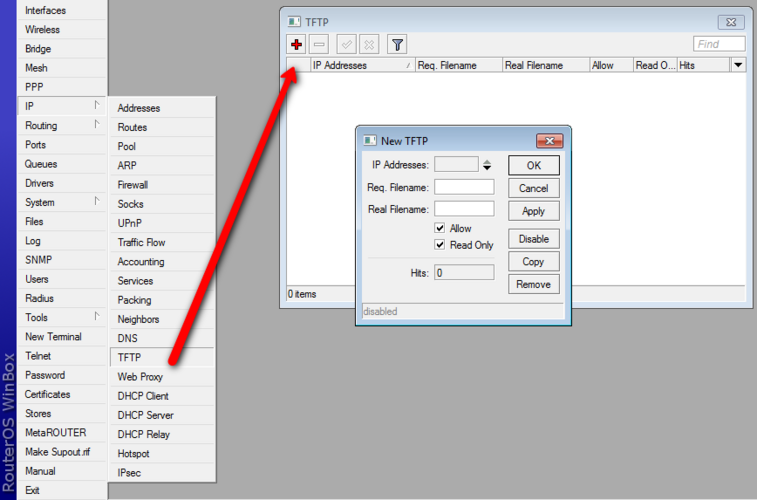Manual:IP/TFTP: Difference between revisions
No edit summary |
|||
| (2 intermediate revisions by the same user not shown) | |||
| Line 58: | Line 58: | ||
!width="450px" style="background:#cccccc; border-bottom:1px solid gray;"| Desciption | !width="450px" style="background:#cccccc; border-bottom:1px solid gray;"| Desciption | ||
|- | |- | ||
|style="border-bottom:1px solid gray;" valign="top"|'''max-block-size (''default: 4096'') | |style="border-bottom:1px solid gray;" valign="top"|'''max-block-size''' (''default: 4096'') | ||
|style="border-bottom:1px solid gray;" valign="top"| maximum accepted block size value. During transfer negotiation phase, RouterOS device will not negotiate larger value than this. | |style="border-bottom:1px solid gray;" valign="top"| maximum accepted block size value. During transfer negotiation phase, RouterOS device will not negotiate larger value than this. | ||
|} | |} | ||
| Line 103: | Line 103: | ||
==Troubleshooting== | ==Troubleshooting== | ||
==== | ==== RouterOS receives TFTP requests, but client get transfer timeout ==== | ||
Some embedded clients request large block sizes and yet do not handle fragmented packets correctly. For these clients, it is recommended to set "block size" value | Some embedded clients request large block sizes and yet do not handle fragmented packets correctly. For these clients, it is recommended to set "max-block-size" on RouterOS side or "blksize" on Client side to value of the smallest MTU on your network minus 32 bytes (20 bytes for IP, 8 for UDP, and 4 for TFTP) and more if you use IP options on your network. | ||
[[Category:Manual|T]] [[Category:IP|T]] | [[Category:Manual|T]] [[Category:IP|T]] | ||
Latest revision as of 10:09, 26 April 2019
Summary
Standards: RFC 1350 RFC 2348
TFTP is a very simple protocol used to transfer files. It is from this that its name comes, Trivial File Transfer Protocol or TFTP. Each nonterminal packet is acknowledged separately. RouterOS has a built-in TFTP server since v3.22

Warning: Since version 4.4 to set up tftp rules you will have to have policy sensitive enabled for your account.

Note: Since RouterOS 5.6 sequence number roll-over is supported by TFTP server. That has to be set specifically for TFTP rule that allows it.
TFTP
Sub-menu level: /ip tftp
This menu contains all TFTP access rules. If in this menu are no rules, TFTP server is not started when RouterOS boots. This menu only shows 1 additional attribute compared to what you can set when creating rule, see explanations of attribute descriptions lower.
| Property | Desciption |
|---|---|
| hits | how many times this access rule entry has been used (read-only) |
Add new access rule
Expansion of command: /ip tftp add
To add new tftp access rule you will have to issue command add under /ip tftp menu with attributes as follows:
| Property | Desciption |
|---|---|
| ip-address (required) | range of IP addresses accepted as clients if empty 0.0.0.0/0 will be used |
| allow-rollover (Default:No) | if set to yes TFTP server will allow sequence number to roll over when maximum value is reached. This is used to enable large downloads using TFTP server. |
| req-filename | requested filename as regular expression (regex) if field is left empty it defaults to .* |
| real-filename | if req-filename and real-filename values are set and valid, the requested filename will be replaced with matched file. This field has to be set. If multiple regex are specified in req-filename, with this field you can set which ones should match, so this rule is validated. real-filename format for using multiple regex is filename\0\5\6 |
| allow (default: yes) | to allow connection if above fields are set. if no, connection will be interrupted |
| read-only (default: no) | sets if file can be written to, if set to "no" write attempt will fail with error |
TFTP settings
Sub-menu level: /ip tftp settings
This menu contains all TFTP settings.
| Property | Desciption |
|---|---|
| max-block-size (default: 4096) | maximum accepted block size value. During transfer negotiation phase, RouterOS device will not negotiate larger value than this. |
req-filename field allowed regexp
allowed regexps in this field are
- brackets () - marking subsection
example 1 a(sd|fg) will match asd or afg
- asterisk "*" - match zero or more times preceding symbol,
example 1 a* will match any length name consisting purely of symbols a or no symbols at all
example 2 .* will match any length name, also, empty field
example 3 as*df will match adf, asdf, assdf, asssdf etc.
- plus "+" will match one or more times preceding symbol,
example: as+df will match asdf, assdf etc.
- dot "." - matches any symbol
example as.f will match asdf, asbf ashf etc.
- square brackets [] - variation between
example as[df] will match asd and asf
- question mark "?" will match one or none symbols,
example asd?f will match asdf and asf
- caret "^" - used at the beginning of the line means that line starts with,
- dollar "$" - means at the end of the line
Examples
- example 1 if file is requested return file from store called sata1:
/ip tftp add req-filename=file.txt real-filename=/sata1/file.txt allow=yes read-only=yes
- example 2 if we want to give out one specific file no matter what user is requesting:
/ip tftp add req-filename=.* real-filename=/sata1/file.txt allow=yes read-only=yes
- example 3 if user requests aaa.bin or bbb.bin then give them ccc.bin:
/ip tftp add req-filename="(aaa.bin)|(bbb.bin)" real-filename="/sata1/ccc.bin\\0" allow=yes read-only=yes
Troubleshooting
RouterOS receives TFTP requests, but client get transfer timeout
Some embedded clients request large block sizes and yet do not handle fragmented packets correctly. For these clients, it is recommended to set "max-block-size" on RouterOS side or "blksize" on Client side to value of the smallest MTU on your network minus 32 bytes (20 bytes for IP, 8 for UDP, and 4 for TFTP) and more if you use IP options on your network.
